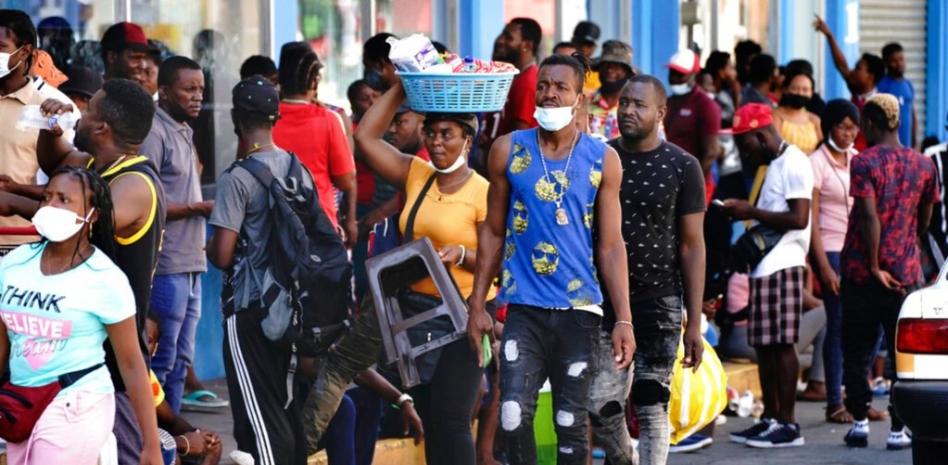For the last 15 years the arrival of Haitians to the country has been registered; back then they numbered in the hundreds.

Haitian refugees in Mexico.
When we talk about diaspora we mean dispersion. In this case, we are interested in discussing the Haitian diaspora in Mexico, where the presence of the population of this Caribbean country is notable and is constantly increasing. The vast majority of people of Haitian origin have arrived in Mexico from other countries through which they have transited, even put down roots, but from which they have had to emigrate again due to adverse economic or political factors. From a broad historical perspective, the Haitian diaspora is the result of a long process.
In the departure of the Haitian population from their country, various triggers are linked, which have given rise to massive displacement, in space and time. In Haiti, deep political problems, chronic economic instability, and in recent times, the impact of socio-environmental disasters are combined. In the last century, the Haitian diaspora has reached destinations as diverse as Barbados, Cuba, French Guiana, Canada and the United States. In this last country, the one with the greatest attraction in the context of a continuously increasing dispersion, there were more than a million first-generation Haitian immigrants and their descendants, according to the figures provided by the 2019 Census of that nation.
The diaspora as a prolonged event is marked by different moments. The last cycle began with the earthquake that struck Haiti in January 2010, a year that represented a turning point in the history of the country and that was marked by the telluric cataclysm, an epidemic outbreak of cholera, the scourge and aftermath of the hurricane, and political problems in the context of the presidential succession. As Marcela Landazábal, a specialist in Latin American Studies and who has studied the issue of Haitian mobility, points out, there is an accumulation of critical conditions after 2010 —read less employment, reduced economic growth, and increased violence— that have fueled the departure of many Haitians from their homeland in the last decade. In this fateful decade, the last “disbandments” of people of Haitian origin have headed to Mexico from Brazil due to the deterioration of economic conditions in that nation, to which they arrived since approximately 2014, and others from Chile due to more restrictive immigration laws since 2018.
Haitian Presence in Mexico
For the last 15 years, the arrival of Haitians to Mexico has been recorded; back then they numbered in the hundreds. In the months after the 2010 earthquake, the Mexican authorities allowed the entry of relatives of those who were already in national territory for purposes of family reunification. Their number was just over 1,000.
In 2016 a new “wave” occurred, it has been estimated that between June and September of that year around 17,000 people of Haitian nationality arrived, mainly from the South American countries mentioned above. Since then the numbers have continued to rise.
There is no way of knowing how many Haitians there are currently in Mexico because we lack official data. However, an indirect way of appreciating the magnitude of their presence is the data from the Mexican Commission for Aid to Refugees, which recorded that more than 51,000 people from that country applied for refugee status in 2021 alone, although it should be clarified that not all Haitians who enter the country request international protection measures, either as a refugee or as complementary protection.
The Haitian people who are arriving in Mexico do not fit with the traditional image and notion of migrants “passing through”. It is a population affected by calamity, a country in a state of constant crisis and, with it, an uncertain future. This uprooting produces and reproduces the diaspora. Like people who migrate from northern Central American countries to Mexico, but even more severely, most Haitians cannot be represented simply as migrating poor, the way they are often portrayed. That label makes it impossible to fully explain the Haitian experience. In many cases they are individuals and family groups fleeing from extreme poverty, yes, but also from various types of violence, such as street violence (gangs), catastrophic conditions (earthquakes, floods, hurricanes), hopelessness which represents living in what some consider to be a state on the verge of collapse, as well as racism and exclusion in other countries where they have resided.
As usually happens with every human group in the same or similar situations, the Haitian experiences of or in mobility have their own particularities, but they are also marked by the suffering, adversity and hope that characterizes the peoples who suffer uprooting, displacement, exile. Haitians in many cases seek bare survival, for this they have migrated or fled to various places or destinations, temporarily and permanently, including Mexico. In this search, a pan-community has emerged, that is, a group of Haitian communities on various continents that unites territories, links, and networks from and to Mexico. In this sense, our country is a point of reference and one more node in the spatial-temporal network of contacts and relationships between family, friends, acquaintances that give continuity to the Haitian diasporic experience.
Luis Alfredo Arriola Vega, researcher with the academic group Estudios de Migración y Procesos Transfronterizos, ECOSUR (larriola@ecosur.mx)
Original article at https://www.cronica.com.mx/academia/apuntes-comprender-diaspora-haitiana-mexico.html?fbclid=IwAR1yp3XX1sFIpkKGkIDmYLXFmXlg-UnKlTF2p8jnHXvpyFKKyP8T-XqOOFo Also available at https://www.ecosur.mx/apuntes-para-comprender-la-diaspora-haitiana-en-mexico/
Translated by Schools for Chiapas.
